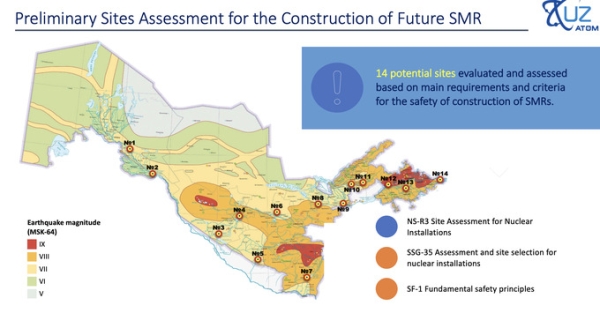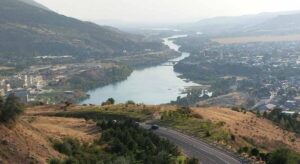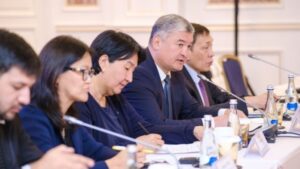“Going nuclear is not only a solution for grid stability; it’s also a strategic investment for the country,” stated Umid Mamadaminov, Deputy Minister of Energy of Uzbekistan, during an international conference in Tashkent on October 15, 2024. In recent days, discussions surrounding the development of nuclear power plants have intensified across Central Asia, driven by Russia’s ongoing advocacy for nuclear energy. A series of high-level events and seminars, led by Rosatom, have underscored the strategic importance of nuclear energy for ensuring energy security, sustainability, and economic growth in the region. From Bishkek, Kyrgyzstan, to Tashkent, Uzbekistan, and Kazakhstan, nuclear energy has emerged as a central theme in the future energy landscape.
Uzbekistan’s Nuclear Energy Plans
As Uzbekistan seeks to diversify its energy sources, nuclear power has become a cornerstone of its strategy. Currently, 88% of Uzbekistan’s electricity is generated from natural gas, but with gas resources depleting and demand for electricity expected to double by 2030, nuclear power offers a sustainable alternative. Mamadaminov emphasized, “The resource for natural gas is going to reduce every year. We need another alternative source of energy, and nuclear is one of the best solutions for that.”
By 2030, Uzbekistan aims to generate 15% of its electricity from nuclear power, while simultaneously reducing natural gas consumption and modernizing its power grid. This shift is part of a broader energy diversification strategy to improve the country’s energy security and reduce reliance on fossil fuels.
The Role of Uranium in Uzbekistan’s Nuclear Future
Uzbekistan, the fifth-largest uranium producer globally, has vast reserves that will play a crucial role in its nuclear energy ambitions. In 2022, the country produced 3,500 tonnes of uranium, primarily through in-situ leaching (ISL), an environmentally friendly mining technique. The uranium is processed at the Navoi Mining & Metallurgy Combinat (NMMC), which handles the entire uranium supply chain, from mining to processing into yellowcake (U3O8).
Mamadaminov highlighted the strategic importance of these resources, stating, “Nuclear energy not only supports our energy independence, but it allows us to leverage our natural uranium reserves for national economic growth.”
Uzbekistan’s uranium resources are crucial not only for domestic nuclear projects but also for exports, with countries such as the United States, South Korea, and China being key buyers. Moreover, joint ventures with companies like Orano (France) and China Guangdong Nuclear Uranium Corp. (CGN) are expanding Uzbekistan’s uranium production capabilities.
Partnerships and Nuclear Infrastructure
The collaboration between Uzbekistan and Rosatom dates back to 2017, when both countries signed an agreement for the peaceful use of nuclear energy. By 2019, a site near Lake Tuzkan was selected for the construction of two VVER-1200 reactors, each with a capacity of 1,200 MWe. Construction is expected to begin soon, with commissioning projected for 2028.

Uzbekistan is also exploring the development of Small Modular Reactors (SMRs), which offer high safety, adaptability, and lower implementation costs. At the same conference as Mamadaminov, Azim Akhmedkhadjaev, head of UzAtom, stated that 14 potential sites for SMRs have been identified, with further studies planned to determine the most suitable locations. “SMRs can be built near consumers due to their smaller footprint and reduced exclusion zones,” he explained, adding that these reactors will also play a role in heating and industrial steam production.
Kazakhstan’s Parallel Nuclear Developments
While Uzbekistan advances its nuclear ambitions, Kazakhstan has also been active in the nuclear energy space. Kazatomprom, the world’s largest uranium producer, announced a major uranium supply deal with China’s CNNC and CNUC, further solidifying its role as a key supplier of nuclear fuel to China’s rapidly growing nuclear market.
It is also worth noting that on August 7, 2024, Uzbekistan and CNNC discussed bilateral cooperation in nuclear energy and signed a Memorandum of Understanding (MOU) and a cooperation roadmap.
In early October, Kazakhstan held a national referendum on the construction of a nuclear power plant near Lake Balkhash, with 71.12% of voters supporting the project. This marks a significant step forward in Kazakhstan’s efforts to secure its energy future through nuclear power. The plant, expected to be built by a consortium of international firms—including potential bidders from Russia, China, South Korea, and France—is part of Kazakhstan’s long-term strategy to diversify its energy sources and reduce reliance on fossil fuels.
Rosatom Leads Nuclear Safety Seminar in Bishkek
On October 14, Rosatom hosted a technical seminar on “Nuclear Power Plant Safety” in Bishkek, Kyrgyzstan, organized in collaboration with the Council of Veterans of Energy of the Kyrgyz Republic. The seminar highlighted the safety, sustainability, and socio-economic benefits of nuclear energy, particularly in regions with high seismic activity.
Dmitry Konstantinov, head of Rosatom’s offices in Kyrgyzstan, reassured attendees about the reliability of modern nuclear technologies. “We are ready to provide safe solutions, especially for regions with high seismic activity,” he stated, emphasizing Rosatom’s commitment to nuclear safety. The seminar also included a virtual tour of the Novovoronezh Nuclear Power Plant, showcasing the world’s first power unit equipped with a VVER-1200 reactor.
A Coordinated Regional Push for Nuclear Energy
The back-to-back discussions in Bishkek and Tashkent, along with developments in Kazakhstan, highlight the coordinated push for nuclear energy across Central Asia. Russia, through Rosatom, is playing a central role in promoting the benefits of nuclear power, offering its technology and expertise to help the region meet its rising energy demands.
As the discussions in Kyrgyzstan, Uzbekistan, and Kazakhstan show, nuclear energy is increasingly seen as a sustainable and reliable solution for the region’s energy needs. However, questions remain about how Western countries will perceive the growing nuclear partnerships between Central Asia and Russia, given the geopolitical complexities involved. And Daryo has previously covered Russia’s use of nuclear diplomacy in the region. Other questions remain as to the viability of these projects in relation to water resources as Central Asia is entering water crisis in the near future.




